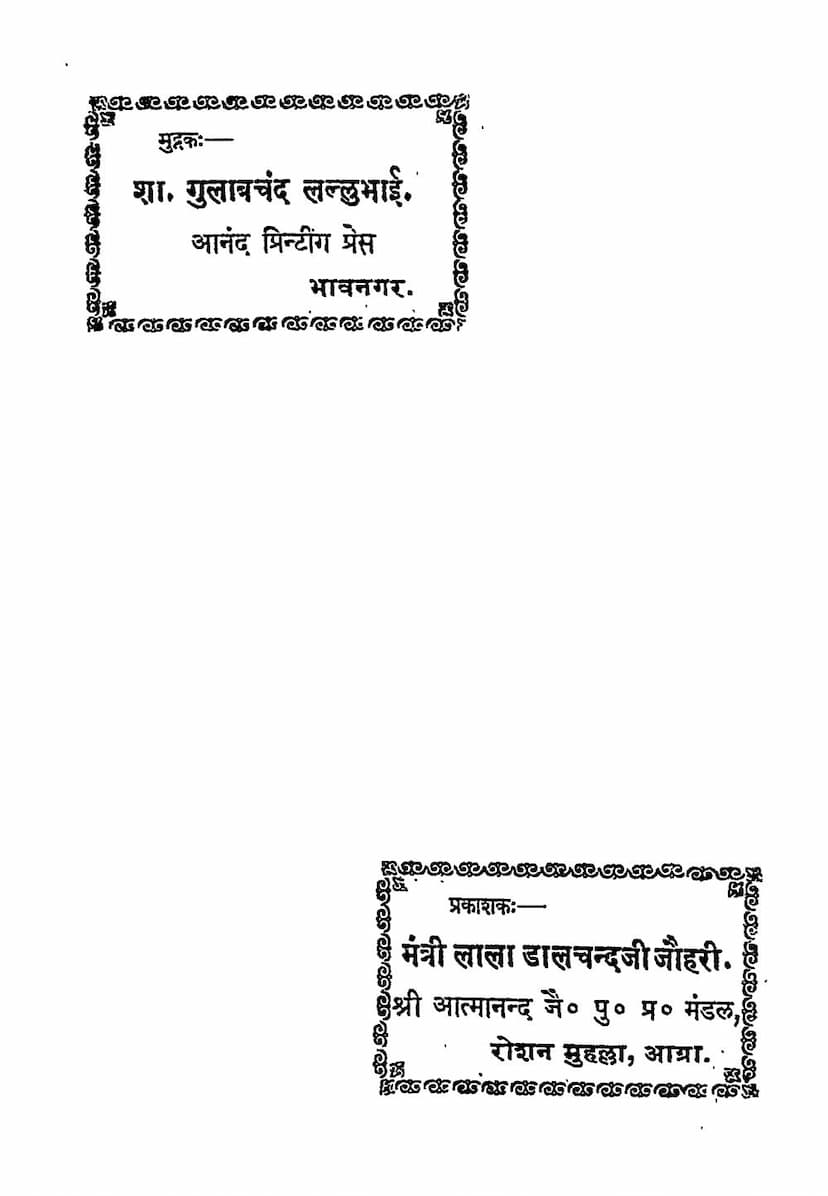Yogdarshan
Added to library: September 2, 2025

Summary
This document is a comprehensive summary of the Jain text "Yogdarshan" by Sukhlal Sanghavi. Here's a breakdown of its key aspects:
Book Title: Yogdarshan Author: Sukhlal Sanghavi Publisher: Sukhlal Sanghavi (printed by Anand Printing Press, Bhavnagar) Dedication: The book is dedicated to Shri Kantivijayji, expressing admiration for his love of knowledge, scriptures, and virtuous monastic life.
Core Content and Structure:
The book is structured to provide a thorough introduction and analysis of Yoga philosophy from a Jain perspective. It primarily focuses on two key texts:
-
Yogavritti (योगसूत्रवृत्ति):
- This is a commentary on the Yoga Sutras of Patanjali.
- It's described as a concise explanation of the Yoga Sutras, which are based on Sankhya principles.
- Crucially, while Patanjali's Yoga Sutras are considered Vedic, this vritti (commentary) is composed from a Jain perspective.
- The vrittikar (commentator) focuses on sutras where there is either agreement or a difference in descriptive method or terminology between Sankhya and Jain philosophies.
- In instances of disagreement, the commentator either refutes the Sankhya interpretation or aligns it with Jain tenets.
- It's presented as a brief demonstration of the similarities and differences between Yoga Darshan and Jain Darshan.
- The commentary is not on all 195 Yoga Sutras but only on 27 of them. The book includes all sutras but only the relevant bhashya (commentary) from Patanjali's Yoga Sutras.
- The author, Upadhyaya Yashovijayji, is highlighted for his effort to bridge the understanding between Vedic and Jain philosophies, promoting mutual respect and clarity.
-
Yogavimshika (योगविंशिका):
- This is a text in Prakrit, consisting of 20 verses (Gathas) on Yoga.
- It is part of a larger series of 20 vimshikas (each 20 verses) authored by Acharya Haribhadra.
- The author, Acharya Haribhadra, is praised for his significant contributions to Jain literature, including being the first to write Sanskrit commentaries on Jain Agamas, the first to systematically describe all Indian philosophies, and a pioneer in presenting Yoga from a Jain perspective.
- The Yogavimshika includes a Sanskrit commentary which is described as clear and complete.
- The text also addresses societal issues, criticizing fraudulent gurus and emphasizing the true meaning of a "Tirtha" (sacred community or place) as one that adheres to scriptures, not merely a congregation of people.
- It concludes with a description of the embodied and disembodied forms of meditation.
Author's Intent and Philosophy:
- Bridging Traditions: A central theme is the bridging of understanding between different philosophical traditions, particularly Vedic (Yoga) and Jain. The author emphasizes the importance of respecting different viewpoints and finding common ground.
- Syadvada: The author highlights that Jain philosophy is rooted in the principle of Syadvada (the doctrine of manifold aspects), which advocates for respecting diverse valid perspectives.
- Promoting Understanding: The inclusion of Hindi summaries of the original texts aims to make this complex philosophical material accessible to a wider audience, fostering a deeper appreciation for the texts and their authors.
- Relevance of Yoga: The introduction emphasizes the universal need for Yoga (stability, concentration) for individual and national success and overcoming despair.
Key Figures Discussed:
- Maharshi Patanjali: The author of the Yoga Sutras, his identity and timeline are discussed, acknowledging scholarly debate. His philosophical depth and lasting influence are recognized.
- Acharya Haribhadra: A prominent Jain scholar, his role in presenting a unique Jain perspective on Yoga is emphasized. His prolific work and intellectual prowess are celebrated.
- Upadhyaya Yashovijayji: The commentator on the Yogavritti and its Sanskrit commentary. He is lauded for his synthesizing abilities, deep study of both Jain and non-Jain texts, and his fearless and impartial approach to presenting truth.
Structure of the Book:
- Introduction/Preface (Prastavana): Discusses the importance of Yoga, the nature of the lecture series, and the purpose of exploring Yoga Darshan.
- Yoga Darshan Overview: Defines Yoga and Darshan, discusses the origin of Yoga, and attributes its development and perfection to India and the Aryan race.
- Yoga and its Literature: Traces the development of Yoga literature across Vedic, Jain, and Buddhist traditions.
- Vedic: Discusses the Rigveda, Upanishads (especially Shvetashvatara), and their contribution to Yoga thought.
- Jain: Highlights the emphasis on meditation and Yoga in Jain Agamas, and the significant contributions of Acharya Haribhadra and Upadhyaya Yashovijayji.
- Buddhist: Briefly mentions Yoga's presence in Buddhist traditions.
- Patanjali's Yoga Sutras: Analyzes the structure and content of the Yoga Sutras, including its four padas (chapters) and the underlying Sankhya principles.
- Jain Philosophy and Yoga: Delves into the similarities and differences between Yoga Darshan and Jain philosophy, focusing on terminology, subject matter, and methodology. This section is particularly detailed, analyzing specific terms and concepts.
- Acharya Haribhadra's Unique Contribution: Discusses Haribhadra's innovation in presenting Yoga from a Jain perspective, including his distinct style and the unique classification of spiritual development.
- Conclusion (Upasamhar): Summarizes the effort and expresses gratitude to contributors and readers, acknowledging the limitations and encouraging further study.
Overall Significance:
"Yogdarshan" by Sukhlal Sanghavi is a scholarly work that aims to provide a bridge between the rich philosophical traditions of Yoga and Jainism. It meticulously analyzes key texts, highlights the contributions of influential scholars, and argues for a harmonized understanding of spiritual practices. The book underscores the Jain philosophical principles of Syadvada and emphasizes the importance of authentic practice guided by scriptures and intellectual rigor.